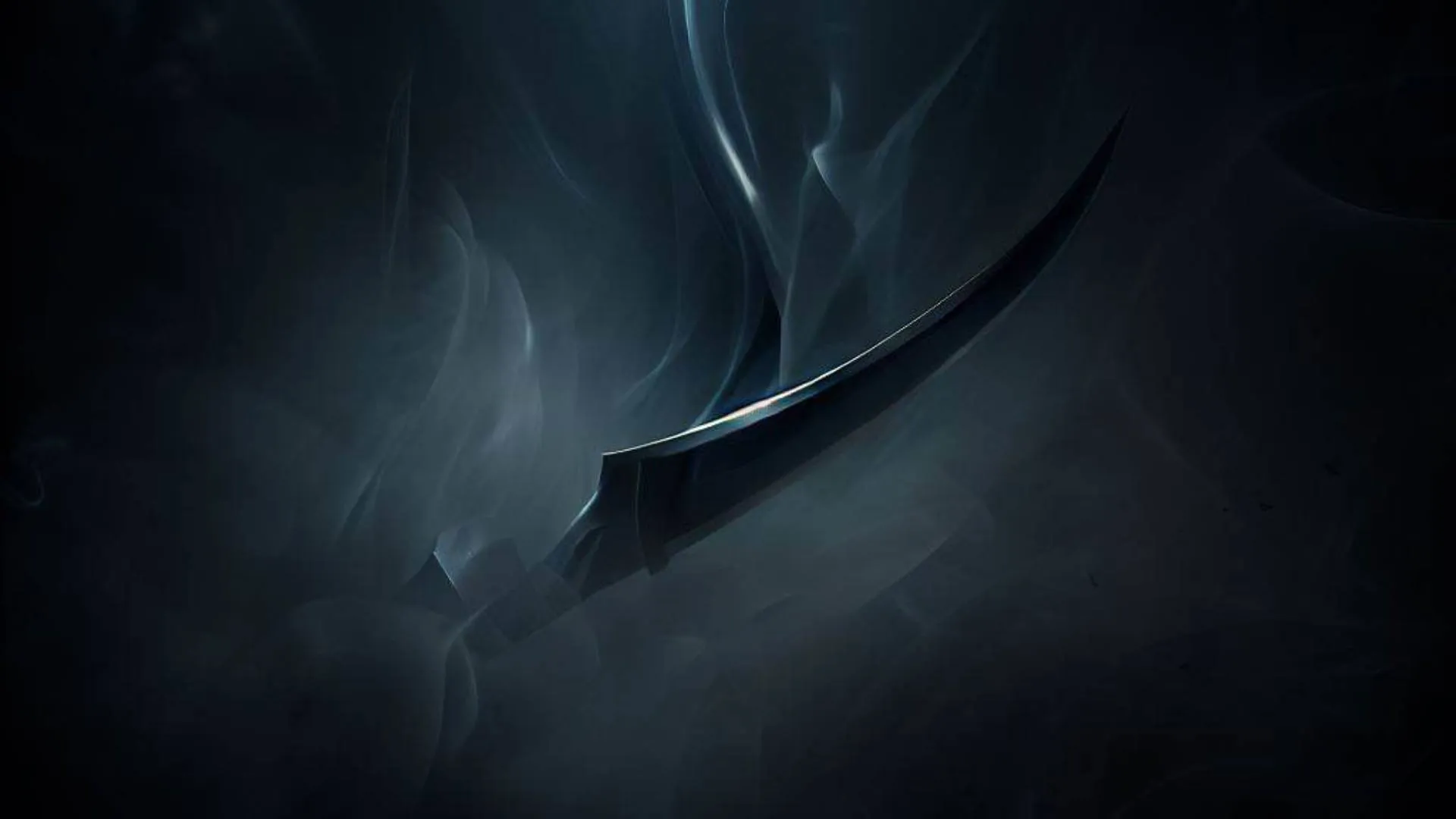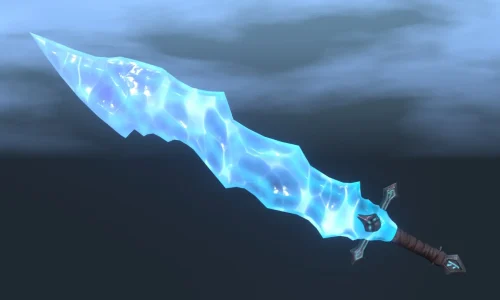Shadow Blade is a powerful spell in DnD 5e that allows casters to conjure a magical sword of darkness. With a mere whisper, the blade materializes, emanating an eerie dim light.
This deadly weapon is favored by those who thrive in darkness, as it grants an advantage on attack rolls in dim light or darkness. Combining stealth and mysticism, Shadow Blade is a spell that unleashes shadowy devastation upon unsuspecting foes.
Spell Mechanism
The Shadow Blade spell in DnD 5e follows a specific set of mechanics:
Casting the Spell
To cast Shadow Blade, the spellcaster must use their action and expend a 2nd-level spell slot. They also need to provide the required verbal and somatic components, speaking the incantation and performing the necessary hand gestures.
Duration
The duration of the Shadow Blade spell is concentration, up to 1 minute. As long as the caster maintains concentration, the blade of darkness remains summoned and usable for attacks.
Blade Creation
When the spell is cast, a magical blade made of darkness materializes in the caster’s hand. This blade is intangible and doesn’t physically exist, but it functions as a melee weapon.
Spell’s Effect
The effect of the Shadow Blade spell is the creation of a magic sword made of darkness. This sword is not a physical weapon but a conjured manifestation of magical energy in the shape of a blade.
Magic Sword
The Shadow Blade takes the form of a sword, specifically a melee weapon. It is usually described as a longsword or a shortsword, but its appearance can vary based on personal preference or the thematic elements of the campaign.
Attack Rolls and Damage
When wielding the Shadow Blade, the caster can make melee weapon attacks using their proficiency bonus and relevant ability modifier. The attack rolls are made using a d20, and if the caster is in dim light or darkness, they have an advantage on the attack rolls.
Weapon Type
The Shadow Blade is a melee weapon in DnD 5e. It is used for close-quarters combat, allowing the caster to engage in melee attacks against enemies within reach.
Weapon Properties
The Shadow Blade does not possess any unique weapon properties. It functions similarly to a regular weapon of its type, utilizing the normal rules and mechanics associated with that weapon.
However, it is worth noting that the weapon’s damage type differs from the normal weapon it emulates (see Damage Type below).
Darkness and Advantage
When wielding the Shadow Blade, the caster gains the advantage on attack rolls when they are in dim light or darkness. This means that they roll two d20s when making an attack and choose the higher result, increasing the likelihood of landing a successful hit.
Damage
The damage inflicted by the Shadow Blade is determined by the normal damage dice associated with the weapon type it emulates. For example, if it takes the form of a longsword, it deals the normal damage of a longsword as specified in the game’s rules.
Damage Type
Unlike the typical damage types associated with physical weapons (such as slashing, piercing, or bludgeoning), the Shadow Blade deals psychic damage.
Psychic damage bypasses many resistances and can be advantageous against creatures with vulnerabilities to such damage.
Dissipation and Reappearance
The Shadow Blade spell requires concentration to maintain in DnD 5e. If the caster loses concentration, the blade dissipates and disappears. However, they can use their bonus action on subsequent turns to recreate the Shadow Blade, provided the spell’s duration has not ended.
Spell Slot Progression
The Shadow Blade spell’s damage scales with higher-level spell slots. When cast using a spell slot of 3rd level or higher, the spell’s damage increases by an additional 1d8 psychic damage for each level above 2nd.
This allows the spell to remain relevant and potent as the caster gains access to higher-level spell slots.
Maximizing the effectiveness
To maximize the effectiveness of Shadow Blade 5e in combat, consider the following strategies:
Lighting Conditions
Shadow Blade grants an advantage on attack rolls when used in dim light or darkness. Manipulate lighting conditions with spells like Darkness or Light to create an advantage for yourself.
Coordinate with your party to control the battlefield’s lighting and ensure optimal conditions for Shadow Blade.
Concentration
Shadow Blade requires concentration to maintain. Protect your concentration by staying out of harm’s way and using defensive spells like Mage Armor or Shield to mitigate damage.
Additionally, consider taking the War Caster feat, which grants an advantage on concentration checks and allows you to cast spells as opportunity attacks.
Class and Subclass Synergies
Choose a class or subclass that complements the use of Shadow Blade. Classes like Hexblade Warlock, College of Whispers Bard, or Bladesinger Wizard can enhance your combat abilities and provide additional benefits when wielding the Shadow Blade.
Multiclassing
Consider multiclassing to maximize damage output. Combining classes that grant extra attacks, such as Fighter or Paladin, with spellcasting classes can increase the number of attacks you can make with the Shadow Blade, amplifying your damage potential.
Spellcasting Features and Feats
Explore spellcasting features that synergize with Shadow Blade. Features like Eldritch Smite (Warlock) or Divine Smite (Paladin) can add extra damage to your attacks when combined with the Shadow Blade.
Feats like Great Weapon Master or Dual Wielder can also boost your damage output.
Tactical Maneuvers
Use tactical maneuvers to gain an advantage in combat. Position yourself strategically to engage enemies vulnerable to psychic damage. Combine the Shadow Blade with spells like Booming Blade or Green-Flame Blade to unleash devastating combos.
Additionally, consider using spells or abilities that provide mobility, such as Misty Step or Cunning Action, to reposition and surprise your foes.
Enhancing the Spell through Spellcasting Features and Feats
To enhance the effectiveness of the Shadow Blade 5e spell, spellcasting features and feats can be utilized:
Eldritch Smite (Warlock)
If you have levels in Warlock, the Eldritch Smite invocation allows you to expend a Warlock spell slot to deal extra damage and potentially knock a target prone when you hit with the Shadow Blade.
This can significantly increase your damage output and provide additional battlefield control.
Divine Smite (Paladin)
If you are a Paladin, you can utilize the Divine Smite feature to expend Paladin spell slots when hitting with the Shadow Blade. This adds radiant damage to your attack, allowing for substantial burst damage against foes.
War Caster (Feat)
Taking the War Caster feat can greatly benefit the Shadow Blade user. It grants an advantage on concentration checks to maintain the spell.
when you take damage, allows you to perform somatic components even with hands full, and lets you use opportunity attacks to cast spells, including Shadow Blade.
Spell Sniper (Feat)
The Spell Sniper feat increases your spell’s range by double and allows you to ignore half and three-quarters cover when making spell attacks. This can be useful when engaging enemies at a distance with the thrown version of the Shadow Blade.
Spell Synergies and Combos
The Shadow Blade spell in DnD 5e can synergize with other spells, creating powerful combinations to maximize its effectiveness. Here are some notable spell synergies and combos to consider:
Darkness
The Darkness spell creates a 15-foot radius of magical darkness, effectively providing dim light or darkness for the Shadow Blade’s advantage on attack rolls.
This combination can be devastating, as you gain an advantage while your enemies struggle to target you accurately.
Booming Blade
By combining Booming Blade with the Shadow Blade, you can add extra damage to your attacks. After hitting with Booming Blade, the target will take additional thunder damage if it willingly moves, making it a potent combo to deter enemies from escaping your reach.
Green-Flame Blade
Similar to Booming Blade, Green-Flame Blade can be combined with the Shadow Blade for additional damage. After successfully hitting with Green-Flame Blade, the flames jump to another nearby enemy, dealing fire damage.
This combo allows you to hit multiple targets with your Shadow Blade strikes.
Haste
The Haste spell can greatly enhance your combat capabilities when combined with the Shadow Blade. It grants you extra action, allowing you to make additional attacks with the Shadow Blade. This combination increases your damage output significantly.
Greater Invisibility
When you cast Greater Invisibility on yourself, you become invisible. This synergizes well with the Shadow Blade, as you can maintain an advantage on attack rolls with the blade due to being unseen by your enemies.
This combo provides a consistent advantage and increases your chance of hitting enemies.
Mirror Image
Mirror Image creates illusory duplicates of yourself, making it harder for enemies to hit you. This spell synergizes with the Shadow Blade in DnD 5e by providing additional protection, helping you maintain concentration and stay in the fray .
Misty Step
Misty Step allows you to teleport up to 30 feet as a bonus action. This spell can be useful for quickly repositioning yourself in combat, ensuring you are within range to make effective attacks with the Shadow Blade.
Magic Items Enhance Spell
There are several magic items in Dungeons and Dragons 5th Edition that can enhance the power and effectiveness of the Shadow Blade spell. Here are a few examples:
Sun Blade
The Sun Blade is a powerful longsword that emits bright light in a 15-foot radius and dim light for an additional 15 feet.
While not directly related to the Shadow Blade, it can complement the spell by providing a source of bright light, allowing you to create dim light or darkness for the Shadow Blade’s advantage on attack rolls.
Sword of Sharpness
The Sword of Sharpness is a magical weapon that increases the chances of dealing with critical hits. When you roll a 20 on your attack roll with the Shadow Blade, this sword allows you to automatically sever a limb of your target or deal extra damage.
This synergizes well with the Shadow Blade’s potential for increased damage.
Belt of Giant Strength
The Belt of Giant Strength increases your Strength score, granting you a higher attack and damage bonus when wielding the Shadow Blade. This item enhances your melee combat prowess, allowing you to strike with greater accuracy and deal more damage.
Ring of Spell Storing
The Ring of Spell Storing can be a useful item for a caster using the Shadow Blade. It allows you to store spells, including the Shadow Blade itself, in the ring and have them ready for use without expending spell slots.
This can provide you with additional casts of the Shadow Blade or other useful spells in combat.
Amulet of Health
The Amulet of Health increases your Constitution score, boosting your hit points and concentration checks. This can be particularly valuable when maintaining concentration on the Shadow Blade spell in the midst of combat.
Cloak of Displacement
The Cloak of Displacement grants you a shimmering illusion that makes it harder for enemies to hit you. It imposes a disadvantage on attack rolls against you, which can help maintain concentration on the Shadow Blade spell and increase your survivability in combat.
Advantages and Disadvantages
| Advantages | Disadvantages |
|---|---|
| Increased damage potential with psychic damage. | Limited duration tied to concentration (up to 1 minute). |
| Advantage on attack rolls in dim light or darkness. | Requires dim light or darkness for advantage. |
| Versatility with summoning and dismissing the blade. | Melee range puts you in potential danger. |
| Can be maintained alongside other concentration spells. | Consumes a 2nd-level spell slot for casting. |
Balancing Shadow Blade
The Shadow Blade spell in DnD 5e can be a potent and versatile option for characters, but it’s essential to consider balance when using it in your campaign. Here are some suggestions for balancing the spell:
Evaluate the Availability
Determine how easily the conditions for gaining advantage on attack rolls with the Shadow Blade can be met. If your campaign has an abundance of dim light or darkness, consider adjusting the availability of such lighting conditions to maintain balance.
Be mindful of providing opportunities for other characters to shine in different environments.
Concentration Management
Monitor the concentration aspect of the spell to ensure it remains balanced. Encounters with enemies that frequently target concentration, such as spellcasters or creatures with abilities like Mage Slayer, can add tension and challenge to maintaining the spell.
Balancing encounters with opportunities for enemies to disrupt concentration can keep the spell in check.
Spell Slot Investment
Consider the balance of using a 2nd-level spell slot for Shadow Blade. Evaluate the damage potential of the spell and compare it to other 2nd-level spells available to characters.
If necessary, adjust the spell level or damage scaling to align with the desired balance in your campaign.
Player Engagement
Encourage players to explore and utilize the other aspects of their characters and classes alongside the Shadow Blade spell.
Encouraging diverse strategies and using the full range of abilities and spells available to the party can maintain a balanced and engaging gameplay experience.
Feedback and Adjustments
Continuously communicate with your players to gather feedback on the balance of the Shadow Blade spell. Monitor its usage and its impact on encounters.
If you notice any issues or imbalances, be open to making adjustments as needed to maintain fairness and enjoyment for everyone involved.
Variant Rule Options for Shadow Blade
These variant rules and homebrew options with your Dungeon Master and fellow players to ensure they fit the overall balance and theme of the campaign.
Customizing the Shadow Blade can add depth and personalization, making it a unique and memorable aspect of your game.
Elemental Variations
As a variant rule, you can customize the damage type of the Shadow Blade spell to suit your campaign. Instead of psychic damage, you could change it to fire, cold, lightning, or another element.
This allows for thematic customization and potential interactions with resistances and vulnerabilities.
Changing Spell Level/Damage Scaling
To adjust the power level of the Shadow Blade spell, you can modify its spell level or damage scaling. Increasing the spell level to 3rd or higher could grant additional benefits while reducing it to 1st or 2nd level might limit its potency.
Similarly, you can tweak the damage scaling to increase or decrease the damage dice based on your campaign’s needs.
Unique Weapon Forms
As a homebrew option, you can allow players to customize the appearance and form of the Shadow Blade. This could include choosing the type of weapon (e.g., sword, axe, or spear) or giving it a unique visual style.
This customization adds flavor and personalization to the spell, allowing players to express their character’s individuality.
Integrating Shadow Blade
Consider how the Shadow Blade can be integrated into your campaign’s setting and lore. For example, in a world with ancient shadow magic, the spell could have ties to a mysterious shadowy order.
This helps create a richer narrative and connects the spell to the broader context of your campaign world.
Conclusion
The Shadow Blade spell in D&D 5e offers exciting combat possibilities with increased damage and advantage. Balancing its availability and concentration aspect is crucial to ensure fairness.
Customization options, like different damage types and unique appearances, add flavor. By considering feedback, adjusting spell levels, and encouraging diverse gameplay, the Shadow Blade can be a valuable asset.
Collaborate with your Dungeon Master and fellow players to create a balanced and enjoyable experience, making the most of this powerful spell in your campaign.








